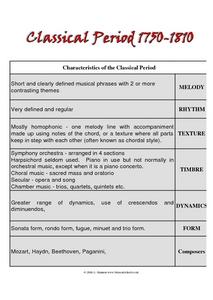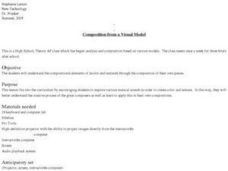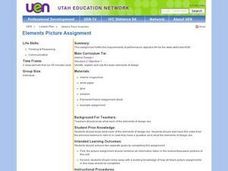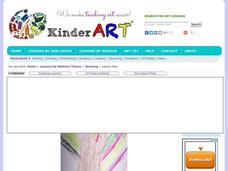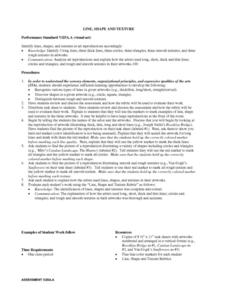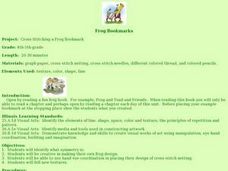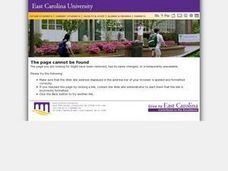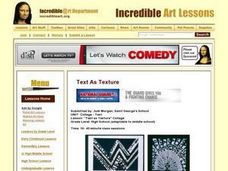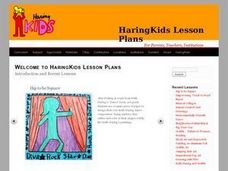Curated OER
Classical Period Music - 1750-1810
In this classical music worksheet, students examine a graphic organizer that explains 7 characteristics of the music. They examine characteristics such as melody, timbre, texture, dynamics, and melody. There are no questions associated...
Curated OER
Elements of Music
In this music worksheet, 7th graders fill in the blanks in 7 sentences that describe the elements of music such as tempo, pitch, decay, and duration. They use the words from a word bank at the bottom of the page. They make a word search...
Curated OER
Identifying Organisms
In this organisms worksheet, 9th graders look at each picture of insects and use the key at the bottom of the sheet to determine which order they belong to. Then they explain which insect is a true bug and which is a true beetle and...
Curated OER
Composing Your Own Song
In this music worksheet, students read about composing their own song and how to get started. They identify the main features that make a good song and the various layers that make up the overall texture. Students also use the three...
Curated OER
Composition from a Visual Model
Students view image of famous artwork, collectively create story about what they see in image, discuss how color and texture could be used to paint picture with music, view second image, and write individual short stories about picture. ...
Curated OER
Elements Picture Assignment
Learners identify the basic structural and decorative designs, create examples of line (horizontal/vertical/curved/diagonal), as well as identify and explain the difference between shape and form. Then, they identify and explain the use...
Curated OER
A Monster's World
Students will use texture to create imaginary monsters and learn about the African American inventor Jan Earnst Matzeliger.
Curated OER
Texture And The World Around You
Young scholars discover different textures used in art by exploring objects, creating magazine montages, and printing collagraphs. The instructional activity spans three days and includes three different activities to aid in the...
Curated OER
Minerals and Rocks
Students identify and interpret various minerals and discover how to identify and classify them. They identify and discuss how people describe objects and how scientists describe objects. From there, students look at a set of common...
Curated OER
Properties of Matter: "Sink or Swim"
Third graders recognize that different materials have different properties which can be observed such as texture and bouyancy, and compare and contrast, through observation, ability of some objects to float because of action of...
Curated OER
Line, Shape, and Texture
High schoolers are introduced to various types of artwork by various artists. In groups, they identify the lines and shapes used by the artist to create a specific texture. They write a paper of their observations and discuss them as a...
Curated OER
Multicultural Literature Lesson Plan The Lotus Seed by Sherry Garland
Sixth graders begin reading "The Lotus Seed" before determining a plant that is a representative of their country or region. They illustrate the plant and write sentences about it and locate the region on a map. Finally, they make a...
Curated OER
Are you going to eat that?
Students identify and define composting. STudents compare and contrast aerobic and anaerobic composting. Students illustrate the benefits of composting and other methods to reuse, recycle, reduce, and respond. Students identify through...
Curated OER
Cross-Stitching a Frog Bookmark
Students identify symmetry and create their own frog design. Students apply hand-eye coordination in placing their designs of cross-stitch netting. Students identify with new textures. Students present and analyze their design once...
Curated OER
Paste Paper
Students watch the teacher demonstrate the process of making paste paper. They create their own wheat paste papers following the example of the teacher. Students make several pieces of paste paper, and use them to make collages.
Curated OER
Animals in the Wild
Students compare/contrast paintings with similar subjects and themes. They discuss how a painting may relate to life experiences. Students draw animal families and compose a story about a painting by Gerome. They discuss zoos and...
Curated OER
Text as Texture Collage
Students explore the concepts of rhythm, movement, contrast and texture. They practice using new vocabulary and work on creating a college after designing the arrangement. They self-evaluate their collage and critique their classmates...
Curated OER
Social Studies: African Power Objects
Learners carve small clay animal tokens as personal talismans. They discuss why people might carry such objects and what they might personally represent to them. Students discuss which animals in Africa could be used as power symbols.
Curated OER
Hands-on Outdoor ABCs
Students go on a walk outdoors in the fall and collect items that start with different letters of the alphabet. They discuss the different textures, colors, shapes (including alphabet shapes), etc. that they found.
Curated OER
Easy and Artistic Printmaking Using Mixed Media Materials
Learners explore printmaking which began with the ancient Chinese who carved seals from stone, inked them and used the seals as identification symbols. They produce a print in this instructional activity.
Curated OER
Tints and Shades in Tempera
Students investigate how to make tints and shades by adding black or white. They apply the new colors to make shapes, patterns and textures.
Curated OER
DRASING NATURE
Learners take samples of local trees and identify the tree using a field guide. They keep data for the tree on the Tree ID sheet. They create leaf, seed, bark, and flower prints and paint them.
Curated OER
Pop Shop 2 - Etching and Woodcutting
Students study printmaking, using mirror images, and positive and negative images. They examine how and why print images and text are used. They use a linoleum blocks to make prints.
Curated OER
Texture: Wild Things
Students experiment with different kinds of marking techniques. They read "Where the Wild Things Are" and observe animals for pattern and line. They compare illustrations with Haring's images. They create a symbolic drawing of animal.


